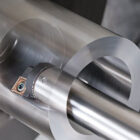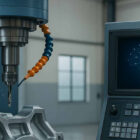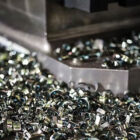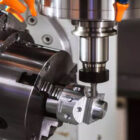When it comes to enlarging and finishing pre-existing holes, boring tools are essential to obtaining precise and accurate machining results. The two main tools are boring bars and boring heads, but they may be made much more functional, efficient, and long-lasting with a variety of add-ons and improvements. To help you get the most out of your boring tools, we’ll go over a variety of accessories in this in-depth tutorial, such as vibration-dampening devices, tool holders, coolant systems, and inserts.
Inserts: The cutting edge of performance
Inserts are essential parts of boring operations as they provide the cutting edge that interacts with the material. The correct insert can enhance the quality of the final product, prolong the life of the tool, and improve tool performance. Surface polish, cutting pressures, and chip formation can all be impacted by the insert’s form and design. The three most popular geometries are wiper inserts, negative rake, and positive rake. In a same vein, inserts come in different grades designed for certain materials and cutting circumstances. A proper grade selection guarantees maximum performance and tool life. There are several insert options available to choose from.
- Carbide inserts: Steel and cast iron are two common hard materials that carbide inserts are perfect for cutting because of their hardness and resistance to wear. They require fewer replacements since they keep their edge sharper for longer.
- Ceramic inserts: Ceramic inserts have good heat resistance and may continue to cut efficiently at high temperatures. They are ideal for high-speed machining of materials like cast iron.
- Cubic Boron Nitride (CBN) inserts: CBN inserts offer better wear resistance and are perfect for machining hardened steels, making them perfect for harsh turning operations.
- Polycrystalline Diamond (PCD) inserts: PCD inserts provide the maximum level of wear resistance and are thus appropriate for lengthy production runs. They are used for non-ferrous and abrasive materials.
Tool holders: For stability and precision
In order to provide stability and accuracy throughout the machining process, tool holders are crucial for fastening boring bars and heads within the machine. Boring operations can be made more accurate and efficient by using a suitable tool holder. For example, especially at high spindle speeds, balanced tool holders can enhance machining accuracy and decrease vibration. However, rapid and simple tool changes are made possible by modular tooling systems, which boost machining efficiency and versatility. Alternatively, dampening devices can be included into anti-vibration tool holders to reduce vibrations and improve surface quality and tool life. Just like inserts, there are a number of tool holder types to choose from.
- Hydraulic tool holders: Hydraulic tool holders provide excellent surface quality and vibration reduction due to its high accuracy and damping qualities.
- Shrink fit holders: These holders grasp the tool by using thermal expansion, which ensures a tight, stable grip with little runout.
- Collet chucks: These tools are ideal for precision boring tasks because of their exceptional concentricity and gripping force.
- Milling chucks: Strong and adaptable, milling chucks are perfect for heavy-duty boring operations where stability is essential.
Coolant systems: Enhancing tool life and performance
In order to avoid overheating, minimize tool wear, and enhance surface finish, efficient cooling and lubrication are essential during machining processes. In boring operations, coolant systems are essential, particularly when working with difficult materials or deep holes. The kind of boring operation, the material being machined, and environmental factors all influence the coolant choice (e.g., oil-based, water-soluble, synthetic). In addition, a variety of additional coolants are available for selection.
- Flood coolant: This is a popular technique in which a substantial amount of coolant is aimed at the cutting region. With its ability to dissipate heat and flush away chips, it is appropriate for the majority of boring activities.
- Mist coolant: This coolant type produces a fine mist by combining coolant with compressed air. This technique is perfect for applications where using too much coolant might cause issues, such delicate electrical parts.
- High-pressure coolant: This type of coolant penetrates deeply into the cutting zone by delivering it at high pressures (often exceeding 1,000 PSI). HPC systems work especially well with materials that produce a lot of heat and for deep-hole boring.
- Through-tool coolant: Coolant is precisely delivered to the cutting edge by passing through the boring bar or head when using the through-tool coolant method. This process guarantees effective lubrication and cooling, especially in narrow and deep bores.
Vibration dampening devices: Enhancing stability and accuracy
When working with lengthy overhangs or hard materials, vibration is a regular problem in boring operations. In order to provide steady and precise machining, vibration dampening devices are made to reduce vibrations. There is a smoother surface finish and better machined products since the vibrations are reduced. The life of the boring tool is increased by reducing vibrations since it lessens the strain on the cutting blades. In summary, consistent machining conditions enable increased cutting rates and feeds, hence augmenting total productivity. The following are the many kinds of vibration dampening devices available.
- Damped boring bars: To reduce vibrations and stabilize the cutting process, internal damping systems, such as hydraulic or tuned mass dampers, should be incorporated.
- Dynamic dampers: To reduce vibrations, external damping devices that are fastened to the head or boring bar should be used. To work at their best, they may be adjusted to particular frequencies.
- Passive dampers: Viscoelastic polymers and composite materials are examples of materials having inherent damping qualities that may be used as passive dampers to lessen vibrations.
In spite of all of the above, to fully leverage the benefits of boring tool accessories and enhancements, and to prolong the life of your tools, you must make sure that boring tool upgrades and accessories are compatible with your current machining setup in order to get the most out of them. you must also ensure that the accessories, such as the spindle type, toolholder interface, and coolant system, fit the specifications of your machine tool. Verify that the size, arrangement, and functionality of inserts, tool holders, and dampening devices match those of your boring bars or heads. Think about the material, surface polish, and bore depth requirements for your boring operation. If you’re unsure about how to install or use a product, consult the manufacturer’s instructions. You may also do trial runs to assess performance and appropriateness and make well-informed judgements on your tooling setup.
Through careful selection of inserts, coolant systems, tool holders, and vibration dampening devices, you may optimize your machining processes to achieve more productivity, better surface finish, and enhanced precision. When selecting these attachments, keep in mind to take operating needs, machine tool specifications, and material compatibility into account. You may produce remarkable outcomes and elevate your tedious tasks with the appropriate set of tools and improvements. Consider FineTech Toolings, one of the most reputed boring tools suppliers in Bangalore, renowned for their inventive and dependable products, for premium boring tools and accessories.






